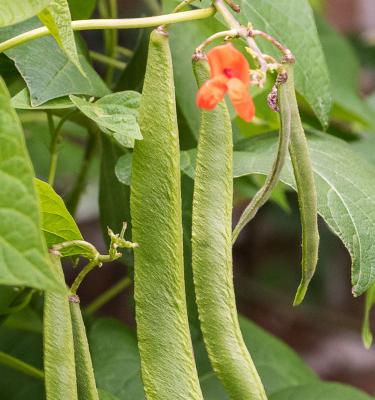

Guide to growing runner beans
Runner beans, or more correctly scarlet runner beans, (phaseolus coccineus) are among the easiest and most rewarding vegetables to grow. And with their colourful flowers and heart-shaped leaves, they look as good as they taste. Follow our simple guide to growing runner beans for a bountiful harvest of runner beans.
When to plant runner beans
- Sow: September to February
- Plant: October to December
- Harvest: December to March
Runner bean varieties to grow
Goliath – flat medium green pods, very high yielding.
Tenderline – slower growing, lower yielding, higher quality less stringy beans.
Shiny Fardenlosa – hard to find for a few years, it is back. Long smooth bright green pods, stringless.
Mangere Pole – good disease resistance, delicious tasting waxy pods.
Butter Bean – flat, light yellow bean, good flavour, keep picking for more beans.
Purple Climbing – smooth, slender pods that turn green when cooked.
Scarlet Runner Bean 7 Years – a climbing bean named for its longevity, cut it down at the end of the season and it comes back year after year. Early cropping large green beans.
Grow your runner beans
Step 1
Sow in small individual pots filled with a quality mix such as Scotts Seed Raising & Cutting Mix.
Step 2
Make a hole in the centre of the pot, place one seed per pot, press the seed at least 5cm deep down into the mix, cover with mix and water well.
Step 3
Leave seeds somewhere warm to germinate. It should take about a week for the seedling to emerge, turn the pot regularly so it grows evenly upwards.
Step 4
When the seeds reach 10cm in height, pinch the tip. The seedling will bush out and develop multiple leaders.
Step 5
Harden the seedlings off before planting out by taking the seedlings outside during the day and bringing it in at night for up to 10 days, this will help reduce transplant shock.
Tip
Protect plants from slugs and snails using Scotts Quash Slug and Snail Killer.
Make a wigwam with four three metre long canes pushed firmly into the soil in a circle. Tie the tops together to make an attractive feature and strong support for the beans.
Planting your beans
Step 1
Prepare the garden bed by digging in Scotts Osmocote Compost & Soil Improver. Dig into the soil to a spade depth. Prepare a climbing frame for the beans before planting.
Step 2
Water plants thoroughly before planting and allow to drain. Dig a hole twice the diameter of the root ball, place the seedling in the centre of the planting hole and back fill, firming around the plant as you go.
Step 3
Loosely tie the beans to the climbing frame and continue tying as the plant grows. Water in well and continue watering regularly.
Step 4
The beans are ready when they are small, slender and 15-20cm long. Pick beans regularly to encourage more flowers.
Tip
To get the best crop of beans and to encourage flowering, apply Scotts Tomato, Vegetable and Herb Controlled Release Fertiliser around the base of the plant.
Growing runner beans in pots and containers
Step 1
Water plants thoroughly before planting and allow to drain.
Step 2
Select a pot with good drainage holes. Party fill the container with Scotts Performance Naturals Vegetable & Herb Mix.
Step 3
Create a wigwam climbing frame in the pot using three bamboo stakes tied at the top to support the climbing beans. As long as the container is large enough, multiple plants can be planted at the base of each bamboo stake.
Step 4
Gently loosen the root ball of the plant and place in the pot, back fill around the plant, firming as you go, so that the mix is 3cm from the top of the pot.
Step 5
Gently tap the pot to settle the mix, press soil around the base of the plant and water well. Continue to water regularly.
Tip
Dwarf runner beans are perfect for growing in pots growing into bushy plants approximately 45cm high.
Runner bean plant care
- Plant runner beans in full sun in well drained soil. Water regularly, especially during dry periods and when the flowers are setting (developing into beans).
- Beans will twine automatically around their supports, but you may need to tie the young seedlings to the poles at first. Once the plants reach the tops of the supports, pinch out the growing tips. This will encourage the plants to put out side shoots and bush up, resulting in more flowers and more beans.
- Check plants for insect pests such as white fly, aphids, green vegetable bug and control them before they become a problem using a broad spectrum insecticide or natural control. Watch for slugs and snails.
- Aphids often appear on young shoots, in large masses they can distort the plant's growth and reduce vigour. Natural predators like ladybirds will help to control infestations.
- If using insecticide sprays, always check that they are suitable for use on edible plants. To avoid harming pollinators, don't spray when the plants are in flower.
Harvesting your runner beans
Harvest runner beans when the pods are between 15-20cm long, before the beans start to swell in the pods, picking encourages the plant to produce more.
In hot, dry weather, flowers sometimes drop off the plant without developing into beans. Regular watering will help, and the problem usually resolves itself once cooler weather returns.



